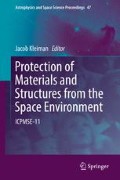Abstract
Optical solar reflectors (OSR) are used for the thermal control of spacecraft on the sun-facing sides of satellites. The operating principle is based on the reflection from incoming solar radiation while simultaneously radiating internally-generated heat. OSR are small specific glasses (40 × 40 × 0.1 mm) surface of which has been treated in order to obtain maximum reflectance of sun irradiation. In some cases, these OSR are manually bonded onto panels and the bonding appears as a time-consuming step in the satellite production because it comes at the end of the production of some structural panels, which are often on the critical path.
In order to improve OSR bonding process, a specific silicone adhesive, called MAPSIL® QS 1123 ELEC LD has been developed, ensuring: relatively small viscosity, long working-time, electrical conductivity and self-adhesion on OSR (Sierra, Development of a specific OSR automated bonding process, 2012). This adhesive has been developed with the following specifications:
-
1.
Development of a silicone based adhesive, mostly used due to its ability to be used in a wide temperature range;
-
2.
Outgassing compliance with the ECSS-Q-70-02C standard (ESA, Thermal vacuum outgassing test for the screening of space materials, 2008);
-
3.
Behaviour towards the space environment which includes UV, e−, p+ and γ irradiation factors. These tests are validated by specific irradiation testing on Earth and/or space, using correlations between duration and irradiation;
-
4.
Have good electrical conductivity in order to avoid electrostatic discharges;
-
5.
Have good thermal conductivity to ensure a good thermal transfer between the satellite and the lightweight panels;
-
6.
Density should be as low as possible to limit the total weight of the OSR—adhesive system to improve the global performance of the satellite;
-
7.
No use of adhesion primer on aluminium substrates and OSR;
-
8.
Good adhesion between aluminium substrates and OSR after thermal cycling under vacuum (−70 to 90 °C), and after damp heat test (50 °C at 95 % of relative humidity).
Moreover, MAPSIL® QS 1123 ELEC LD has been developed in accordance with ISO 9001 and EN9100 standards ensuring quality of the products and it is ITAR and EAR free as it is a co-development of a French company (MAP) and the French Space Agency (CNES).
Access this chapter
Tax calculation will be finalised at checkout
Purchases are for personal use only
References
Sierra G (2012) Development of a specific OSR automated bonding process. In: Proceedings of 12th international symposium on “Materials in the space environment”, Noordwijk
ESA (2008) Thermal vacuum outgassing test for the screening of space materials. ECSS-Q-ST-70-02C
Guillaumon O, Remaury S, Guigue P (2008) Development of an ITAR free silicone adhesive for space use: MAPSIL® QS 1123. In: 9th ICPMSE, Toronto, Canada
Marco J, Remaury S, Tonon C (2009) Eight years GEO ground testing of thermal control coatings. In: 11th ISMSE, Aix-en-Provence, France
Guillaumon O, Remaury S, Nabarra P, Guigue P, Combes H (2009) Development of a new silicone adhesive for space use: MAPSIL® QS 1123. In: 11th ISMSE, Aix-en-Provence, France
Remaury S (2011) ESD test results of silicone adhesives on OSR assemblies. CNES report DCT/TV/TH/NT11-8705
Remaury S (2010) Eight years GEO ground testing of thermal control coatings. CNES report DCT/TV/TH/NT10-1267
Remaury S (2009) Qualification report—MAPSIL® QS1123 silicone resin. CNES report DCT/TV/TH/09-14628
Remaury S (2011) Thermal conductivity measurement of MAPSIL® QS1123. CNES report DCT/TV/TH/NT09-6039
Levan L, Rohr T, Van Eesbeek M (2009) MAPSIL® QS1123 material investigation. ESA report N°5880
Herrera Hernandez A (2011) Outgassing test report DMAV1118
ISO 4587: 2003 Adhesives—determination of tensile lap-shear strength of rigid-to-rigid bonded assemblies. AFNOR standard
MAPSIL® QS 1123 ELEC LD (2013) CNES qualification report DCT-TV-TH 2013-2456
Author information
Authors and Affiliations
Corresponding authors
Editor information
Editors and Affiliations
Rights and permissions
Copyright information
© 2017 Springer International Publishing AG
About this paper
Cite this paper
Sierra, G., Guillaumon, O., Sacramento, D., Remaury, S., Nabarra, P. (2017). Development of a Silicone Adhesive for OSR Bonding. In: Kleiman, J. (eds) Protection of Materials and Structures from the Space Environment. Astrophysics and Space Science Proceedings, vol 47. Springer, Cham. https://doi.org/10.1007/978-3-319-19309-0_21
Download citation
DOI: https://doi.org/10.1007/978-3-319-19309-0_21
Published:
Publisher Name: Springer, Cham
Print ISBN: 978-3-319-19308-3
Online ISBN: 978-3-319-19309-0
eBook Packages: Physics and AstronomyPhysics and Astronomy (R0)

